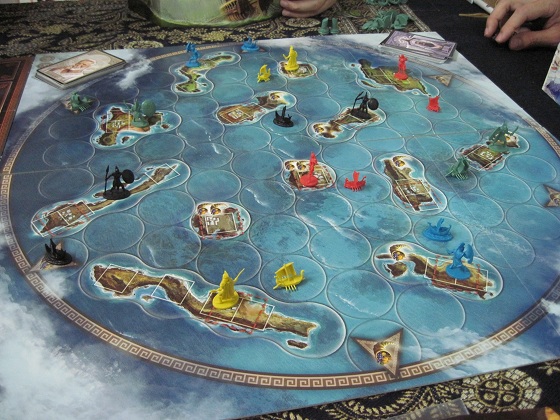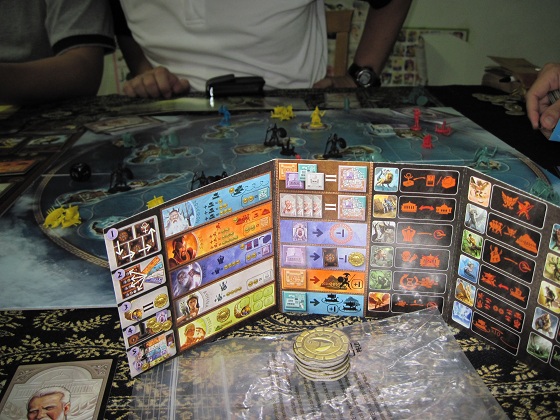
Since leaving Kota Kinabalu, Hiew has been kind enough to invite me to his so-called “Midah Group” sessions. So far I’ve only been there once and I probably won’t be able to join them very often before I have to move away again. We only arrived at 9 PM and so played only two games. Cyclades and a family game that goes by the awkward name of Fast Flowing Forest Fellas. The latter isn’t very interesting to me. It’s very reminiscent of Niagara, but is much simpler and seems mostly luck-based due to the importance of having the right card in hand at the right time. I think Niagara is the better game in every way, so I won’t be writing much about this one.
Cyclades on the other hand has been something that I’ve been intrigued by since I first read Hiew’s post on it because it looks like a Eurogame-Ameritrash hybrid. It has invasions and combat. It uses mythological Greece as its theme. And it comes with plastic figures depicting soldiers, ships and even monsters. After playing it however, I’ve found it to be much more of a Euro that I expected as there is usually only one invasion event per round. This means that victory is still more about building things than conquering to grab islands from others. My thoughts:
- Contrary to expectations, this plays more like a bidding game than anything else. The most important part of the game is deciding what action you really need and how much you’re willing to pay for it. Since there is only just enough actions to go around, competition is always tight. The only action that more than one player can take is a consolation prize action which gives you a bit of money, and if you’re the first player to take it, a resource boost that you can choose to put on any island.

- The order that each action type is executed in a given round is randomized, which gives the game a bit of extra dynamism. But it only really matters for the Poseidon action, which allows you to buy and move ships, and the Ares action, which allows you to buy and move soldiers. I suppose the order in which people are able to access monsters is important as well.
- Monsters act like special actions that you can choose to pay extra for, which means they don’t really feel like monsters at all. The Pegasus monster for example lets you fly your troops to attack any island you want, making it especially desirable. The Medusa simply locks down all soldiers at an island for one turn, preventing them from moving away. As a first-time player, I found it hard to keep all of the monsters’ special abilities in mind which, as is the norm in Euro games, is summarized only using iconography on the individual cards.
- As usual for me, I agonized far too much over the risk of losing my islands and forgot to actually do things that could lead to winning. I’d managed to get a decent income going pretty early on and actually kept that income for the whole game. But I only took defensive actions and never built many buildings. I was also far too cautious with my money and should have been willing to spend everything I have to get what I really wanted. Han won the game because he had one Metropolis already but everyone thought that Hiew was the leading player and didn’t pay enough attention to Han.

- Shan invested heavily in one single island without bothering to protect it properly but that made the island irresistible to Allen who promptly conquered it and decided to burn of its buildings for cash. Shan then went to great lengths to get that island back. Most of us thought that this was sub-optimal play and that she wanted to get it back as a matter of principle but she swears that she thought it was still the best move for her.
- Combat still does use a die, though the randomness is minimized by having 0, 1, 1, 2, 2 and 3 as results. In our game, the player with more forces won every single time, but I’d still bet that this will be a constant target of complaints. I guess it’s good to ensure that the results of combat is never a certainty and that upsets are possible, however unlikely they are.
Overall, I found this game to be just okay. I guess that I’m somewhat disappointed by how Euro-style it is given the coolness of its theme. It feels kind of weird to see a Medusa figure on the board and not be able to fight it for treasure or something. It does have the virtue of not taking much time to play at all while the smallness of the map ensures that invasion is always a possibility right from the start. It’s not a bad game. It’s just that I don’t see anything particularly novel or exciting here, save for the unusually high quality of the art and the figures.
Leave a Reply